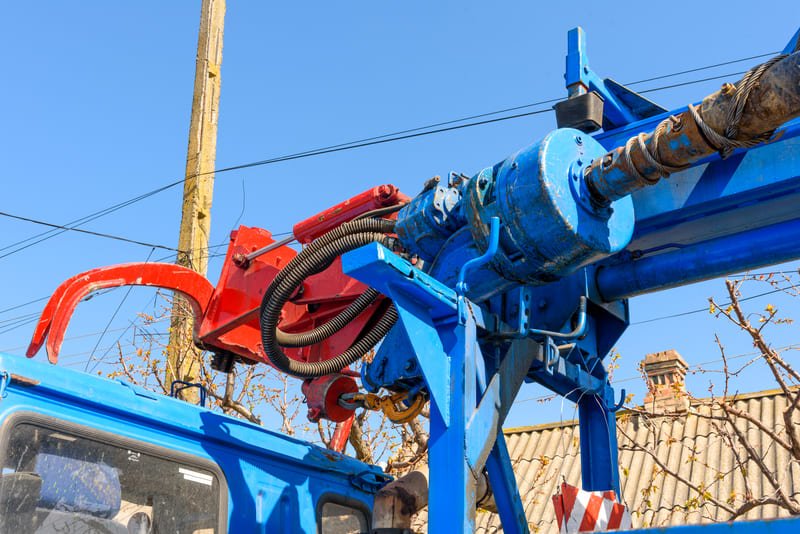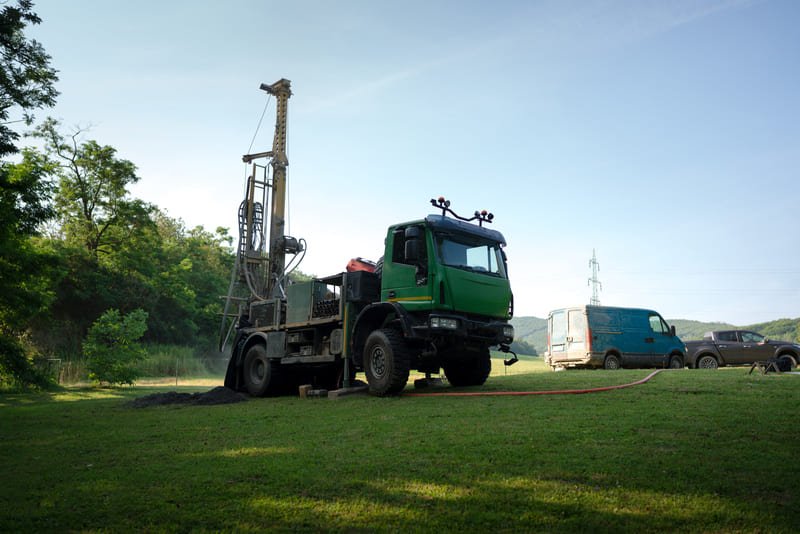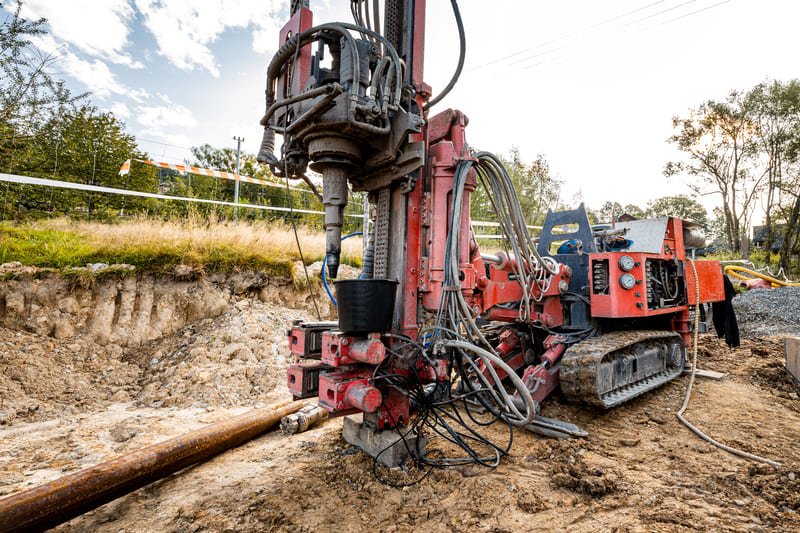Have you ever stood in awe before the towering structures of a drilling rig? These engineering marvels are not just impressive; they are vital to our modern world.
A drilling rig is a machine used to create holes in the earth's surface for resource extraction, primarily oil and gas. It functions by rotating a drill bit, hoisting equipment, circulating drilling fluids, and controlling various parameters to optimize the process.
But wait, there's so much more beneath the surface! Let’s dive into the intricate workings of these incredible machines.
Drilling rigs are used for oil and gas extraction.True
Drilling rigs create wells to access underground oil and gas reserves.
What Are the Main Components of a Drilling Rig?
Drilling rigs are complex structures that include various components working in harmony to extract resources efficiently.
The main components of a drilling rig include the derrick, drill string, rotary system, circulation system, blowout preventer, and power generation units. Each part plays a critical role in ensuring the rig's functionality and safety during operations.

Derrick: The Towering Framework
The derrick is the most prominent feature of a drilling rig, often towering over the rest of the equipment. This tall structure supports the drill string and provides the necessary height to hoist equipment in and out of the wellbore. A derrick1 is typically made of high-strength steel to withstand heavy loads and adverse weather conditions.
Drill String: The Heart of the Drilling Process
Comprising multiple sections of drill pipe, the drill string is crucial for transmitting rotary motion from the surface to the drill bit. It includes various components like drill collars and stabilizers, which add weight and stability to the drilling process. The efficiency of the drill string2 directly impacts the rate of penetration and overall success of drilling operations.
Rotary System: Enabling Rotation
The rotary system converts power into rotational force, allowing the drill bit to bore through rock formations. It consists of the rotary table or top drive, which rotates the drill string. This component's design can vary depending on whether the rig is land-based or offshore.
Circulation System: Managing Fluids
A critical component, the circulation system moves drilling fluid (or mud) down the drill string and back up the wellbore. This process cools the drill bit, removes cuttings, and stabilizes the wellbore. The circulation system3 includes pumps, mud tanks, and pipelines.
Blowout Preventer: Ensuring Safety
Safety is paramount in drilling operations, and the blowout preventer (BOP) plays a key role. It seals the wellbore to prevent uncontrolled releases of oil or gas. The BOP is installed at the wellhead and can be activated manually or automatically in case of an emergency.
Power Generation Units: Fueling Operations
Drilling rigs require significant power to operate all their systems. Power generation units, usually diesel engines or generators, provide this energy. They ensure continuous operation by supplying power to all other components, including pumps, motors, and lights.
Each component works in tandem to ensure that drilling operations are not only efficient but also safe and environmentally responsible.
Derricks are made of high-strength steel.True
Derricks are designed to withstand heavy loads and weather.
The circulation system stabilizes the wellbore.True
It moves drilling fluid to cool and stabilize the wellbore.
How Do Different Types of Drilling Rigs Differ in Functionality?
Ever wondered why different drilling rigs are used for various extraction tasks? It's all about functionality.
Drilling rigs vary in functionality based on their design, such as rotary, percussion, and directional rigs, each tailored for specific drilling tasks. Rotary rigs excel in continuous drilling, percussion rigs are suited for harder rock formations, and directional rigs allow for angled drilling paths.

Rotary Drilling Rigs
Rotary drilling rigs are the most commonly used rigs in the oil and gas industry. They operate by rotating a drill bit to bore through the earth's surface, making them ideal for deep wells. The continuous rotation facilitates faster penetration and is suitable for soft to medium-hard rock formations. These rigs can be either land-based or offshore, with land rigs being more mobile and adaptable to varying terrains.
| Feature | Description |
|---|---|
| Drilling Method | Continuous rotation of drill bit |
| Best Suited For | Deep wells, soft to medium-hard formations |
| Mobility | High, especially for land-based rotary rigs |
Learn more about rotary drilling rigs4
Percussion Drilling Rigs
These rigs function by repeatedly lifting and dropping a heavy drill bit into the ground. This action crushes the rock at the bottom of the hole, making it effective for hard and dense rock formations. Percussion drilling is slower than rotary drilling but offers greater control over the drilling process in challenging geological conditions.
| Feature | Description |
|---|---|
| Drilling Method | Repeated lifting and dropping of drill bit |
| Best Suited For | Hard, dense rock formations |
| Speed | Slower compared to rotary drilling |
Explore the use of percussion drilling rigs5
Directional Drilling Rigs
Directional drilling rigs allow operators to steer the drill bit along a planned path, which is particularly useful for reaching reservoirs that are not directly beneath the drill site. This capability is crucial in urban areas or environmentally sensitive regions where surface disruption needs to be minimized.
| Feature | Description |
|---|---|
| Drilling Method | Steered path based on planned trajectory |
| Best Suited For | Non-vertical well paths, urban or sensitive areas |
| Flexibility | High, can reach multiple reservoirs from one site |
Discover how directional drilling revolutionizes extraction6
Each type of rig brings unique capabilities to the table, dictated by the geological conditions and specific objectives of a drilling project. This variety ensures that industries can efficiently and safely extract resources from diverse environments.
Rotary rigs are best for soft rock formations.True
Rotary rigs excel in continuous drilling, ideal for soft to medium-hard rocks.
Percussion rigs are faster than rotary rigs.False
Percussion drilling is slower, providing greater control in hard rock conditions.
What Role Does Fluid Circulation Play in Drilling Operations?
Fluid circulation is pivotal in drilling, ensuring stability and efficiency throughout the process.
Fluid circulation in drilling operations is crucial for cooling the drill bit, removing cuttings, and stabilizing the wellbore. It involves pumping drilling fluid down the drill string and back up the annulus, creating a continuous flow that supports multiple functions critical to safe and efficient drilling.

Understanding Fluid Circulation in Drilling
In drilling operations, fluid circulation refers to the continuous movement of drilling fluid, or "mud," which is essential to several functions. This process begins with pumping the fluid down through the drill pipe. The fluid exits through the drill bit nozzles at the bottom of the well, carrying cuttings to the surface through the annular space between the drill string and the wellbore walls.
Functions of Drilling Fluid
-
Cooling and Lubricating
The drilling fluid7 plays a vital role in cooling and lubricating the drill bit. The friction generated by the rotation of the drill bit against rock formations can cause heat buildup. Without proper cooling, this could lead to overheating and damage.
-
Removing Drill Cuttings
As drilling progresses, rock cuttings are produced, which need to be removed from the wellbore efficiently. The circulating fluid transports these cuttings to the surface, preventing blockages that could lead to increased pressure and potential blowouts.
-
Maintaining Wellbore Stability
Drilling fluid also helps maintain wellbore stability by exerting hydrostatic pressure on formation walls. This pressure helps prevent cave-ins and controls formation fluids.
Composition and Properties of Drilling Fluids
Drilling fluids are composed of various elements tailored to specific drilling conditions. Here’s a simple breakdown:
| Property | Function |
|---|---|
| Viscosity | Helps lift cuttings to the surface |
| Density | Controls subsurface pressure |
| Gel Strength | Prevents cuttings from settling |
| pH Balance | Protects against corrosion and formation damage |
Challenges and Innovations
One challenge in fluid circulation is managing its properties in real-time. Technologies such as Managed Pressure Drilling (MPD) enhance this by allowing adjustments in response to downhole conditions, offering more control over pressure and fluid properties.
Another innovation is using synthetic-based muds that are less damaging to sensitive environments than traditional oil-based muds, helping to reduce environmental impact8 while maintaining performance.
Fluid circulation cools the drill bit in drilling operations.True
Drilling fluid absorbs heat generated by friction, cooling the drill bit.
Drilling fluid circulation does not affect wellbore stability.False
Fluid exerts pressure on formation walls, maintaining wellbore stability.
Why is Control Crucial in Drilling Rig Operations?
Discover why control is the unsung hero in the complex world of drilling rig operations, ensuring efficiency and safety.
Control in drilling rig operations is essential for optimizing performance and ensuring safety. It involves managing drilling parameters like speed, torque, and fluid circulation to prevent accidents and enhance productivity.

Understanding Control in Drilling Operations
Control in drilling operations is not just about maintaining order; it's about precision management of several dynamic factors. A drilling rig must operate under carefully controlled conditions to avoid catastrophic outcomes such as blowouts or equipment failure. Operational parameters9 like drill speed, torque, and fluid circulation are meticulously monitored and adjusted to match the geophysical conditions encountered.
Importance of Control Systems
Modern drilling rigs are equipped with sophisticated control systems. These systems use real-time data to adjust operational parameters automatically. For instance, they can alter the weight on the drill bit or modify the rate of fluid circulation. This adaptive capability is crucial for accommodating unexpected changes in well conditions. Advanced control systems10 reduce the risk of human error, allowing for safer and more efficient operations.
Case Study: Control Failures
Analyzing past incidents where control mechanisms failed provides insight into their importance. For example, the infamous Deepwater Horizon disaster highlighted the consequences of inadequate control. Poorly managed pressure led to a blowout, causing significant environmental damage. Implementing robust control measures can prevent such occurrences, safeguarding both the environment and rig personnel.
Control and Technological Innovations
Technological advancements have revolutionized control mechanisms in drilling rigs. Automated systems using AI and machine learning algorithms can predict potential issues before they occur. These technologies offer real-time insights, enabling preemptive adjustments that maintain optimal drilling conditions. As such, control is not only crucial for current operations but also pivotal in advancing future drilling technologies.
Control prevents blowouts in drilling operations.True
Proper control of parameters like pressure and speed prevents blowouts.
AI has no role in modern drilling control systems.False
AI enhances drilling control by predicting issues and optimizing parameters.
Conclusion
Drilling rigs are vital to energy extraction, combining technology and engineering to perform complex tasks efficiently. Understanding their operation enhances appreciation for their role in powering the world.
-
Learn how derricks support heavy loads in drilling operations.: In the oilfield, a derrick is a support structure that holds the drilling apparatus. It acts as the framework supporting a drilling ... ↩
-
Explore how drill strings impact drilling efficiency.: A drill string on a drilling rig is a column, or string, of drill pipe that transmits drilling fluid (via the mud pumps) and torque to the drill bit. ↩
-
Understand the role of circulation systems in cooling and stabilizing.: The circulation system on the rig is the system that allows for circulation of the Drilling Fluid or Mud down through the hollow drill string and up through ... ↩
-
Gain insights into how rotary drilling rigs operate.: Rotary drilling uses a rotating drill bit with nozzles for shooting drilling mud into the wellbore. Drilling mud is a combination of clay and water. The rotary ... ↩
-
Understand why percussion drilling is ideal for tough conditions.: Percussion drilling is employed when auger or wash boring is not possible in very stiff soil or rock. It also can be used in most soil types. ↩
-
See how directional drilling enhances resource extraction.: Directional drilling by using the mud motor means that often the drill pipe needs to be slid forward while the drill is motionless. A rotary steerable system ... ↩
-
Discover how drilling fluids enhance efficiency and safety in drilling.: Drilling fluids serve many functions: controlling formation pressures, removing cuttings from the wellbore, sealing permeable formations ... ↩
-
Learn about eco-friendly alternatives to conventional drilling fluids.: Abstract: Synthetic-based muds have been used to simultaneously improve drilling and environmental performance. The fate and effects of synthetic-based mud ... ↩
-
Learn how managing parameters ensures safety and efficiency in drilling.: Drilling optimization has an important role in improving drilling performance and reducing unnecessary drilling costs. ↩
-
Explore how cutting-edge systems enhance precision and safety.: Leading the industry in rig automation, our control systems seamlessly integrate drilling equipment, improve performance, and boost drilling efficiency. ↩








